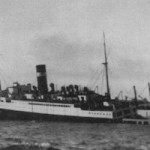“Greyhound,” the new World War II movie starring Tom Hanks, depicts a U.S. Navy destroyer’s harrowing effort to protect a convoy of ships crossing the Atlantic Ocean from North America to the British Isles. The voyage takes place in early 1942, shortly after the United States entered the war, and at a time when German U-boats held the upper hand in the Battle of the Atlantic.
Convoys were an attempt to counter the ever-present U-boat threat to Allied merchant shipping. The threat was greatest in the mid-Atlantic “black pit,” roughly 50,000 square miles that could not be protected because of the limited range of Allied land-based aircraft.
The convoy – a grouping of merchant ships in a disciplined formation protected by a squadron of warships – was successfully employed late in World War I. Initially, merchant sea captains had been reluctant to sail in tight formations, fearful of collisions in the foggy, storm-tossed North Atlantic. Convoys, they said, would present attractive targets for U-boats, and could sail only as fast as the slowest ship, thus prolonging exposure to attack.
But as U-boats sank an increasing number of merchant ships sailing alone in World War I, the wisdom of the convoy system became apparent. While it took three years of naval warfare before Britain instituted convoys in World War I, it took the British Admiralty less than a week following Athenia’s sinking to establish the convoy system in World War II.
A convoy might consist of from 45 to 60 merchant ships, arranged in nine to twelve columns, each ship maintaining 900 yards from the ship in front of it. Each of the columns was separated by 1,000 yards. The formations could be up to four miles wide and two miles long, with the most vulnerable ships – troop carriers and tankers – in the center. A convoy was protected by ten or more escort warships, depending on availability and convoy size. As depicted in “Greyhound,” these escorts were mostly small, fast and maneuverable: typically destroyers and corvettes, the latter being a smaller, British-designed ship tailored for escort duty.
The German tactic of the “wolf pack,” a gathering of up to a dozen or more U-boats, was developed to conduct coordinated attacks on convoy formations. Wolf packs proved effective through the first half of the war, but as “Greyhound” makes clear, these sea battles always carried some risks for U-boat captains.
By mid-1943, Allied advances in detecting, locating, and attacking U-boats turned the tide in the Battle of the Atlantic. In May of that year, U-boats sank 34 merchant ships, but at a cost of 34 U-boats, a one-to-one ratio that Germany could not sustain.
Although sporadic attacks on convoys would continue through the final two years of the war, the German navy’s U-boat commander, Admiral Karl Doenitz, acknowledged Germany had lost the Battle of the Atlantic that summer of 1943.




